Special Report: Retreating 100 Miles West of Cary
Editor’s Note: For the fourth consecutive year, Brent Miller has covered the Council-Staff Retreat for CaryCitizen. As one of only two media outlets in attendance, we offer this in-depth report on the strategic direction Town Council and Staff will take in the next year.
Retreating 100 Miles West
By Brent Miller for CaryCitizen
This year’s Cary Town Council and Staff retreat was held in Winston-Salem on Friday and Saturday January 17 – 18. All seven Cary Town Council members attended, along with 23 senior staff members. These annual retreats have been held in various places over the years, including Wilmington, Southern Pines and even once right at home in Cary. The retreats are designed to foster “big picture” strategic thinking and explore various issues in depth, as well as to promote relationship building among council and staff members.
Council has generally gravitated to out-of-town retreats. As District B councilman Don Frantz explained, too many distractions occur when the retreat is held locally. He noted that when the retreat was held in Cary, people would get calls and texts and sometimes even leave the meeting; they would then need to be brought up to speed on what they missed, and the group lost focus, attention and efficiency. By holding the retreat away from home, distractions are decreased and focus and interactions are improved. Frantz noted that citizen participation has not been affected by location; very few citizens attend these public meetings, even when held in Cary. The cost is not much more for out of town retreats.
Getting Ready
This year’s agenda included focused discussions about economic development, communications and priority-based budgeting. A highlight of the retreat was a tour of downtown Winston-Salem. Two “spotlights on success” were presented, addressing the WakeMed Soccer Park and Cary’s new Fire Station #8.
The retreat was facilitated by Michelle Ferguson of the Novak Consulting Group.
Getting Underway
To kick things off, each participant was asked to state their goals and objectives for the session.
Town Manager Ben Shivar told CaryCitizen that he expected to obtain Council’s direction for the three main topics. Specifically, for economic development, an objective is to identify focus areas and Council’s vision for future. For communications, Staff sought direction from Council for future emphasis areas, especially for the issues identified by groups such as the Technology Task Force, as well as how to best apply limited resources for branding, public communications, web and social media and other communications venues. For priority-based budgeting, the objective was to identify Council’s long-term goals and align the budgeting process with the overarching goals.
In his opening remarks, Mayor Harold Weinbrecht observed that retreats help make council and staff more efficient, make Cary a better town and set clear direction. Cary is the most efficient town in the state and has a high quality of life with low taxes. Mayor Weinbrecht cited a recent email that thanked the town for taking care of a downed tree in just one day and noted that such communications are exemplary of the many positive emails he receives. He thanked and congratulated town staff for their dedication.
District C councilman Jack Smith stated that he hoped that town leaders could coalesce around economic development and find the most effective methods to use. He looked forward to getting new, fresh ideas from people new to the retreat. At-large council representative Lori Bush was excited about the entire agenda, but especially looked forward to the communications topic. District D councilwoman Gale Adcock looked forward to hearing all of her colleagues play off of each other.
District A representative Jennifer Robinson anticipated collaborative discussions about the challenges Cary faces. At-large councilman Ed Yerha expected to learn more about all topics, noting that all of them are are interesting and he looked forward to hearing from the various experts on those topics. District B representative Don Frantz hoped to build on existing relationships, get to know staff members better and foster team building.
Following a brain-teaser puzzle, Town Manager Ben Shivar showed a video about “cathedral thinking”, the idea that people can start working on something that will outlive them; hence, they won’t live to see the final results of the effort — much like building a cathedral, a process that might span centuries.
After reviewing some ground rules for the session (listen with respect, be candid and honest, strive for consensus, be open to re-frame possibilities), it was off to board the bus for a tour of downtown Winston-Salem.
Touring Downtown Winston-Salem
Cary Downtown Manager Ted Boyd led the tour, with assistance from Jason Thiel, president of the Downtown Winston-Salem Partnership. With a population of about 230,000, Winston-Salem has a large downtown that is a mix of historic and modern properties, including commercial, residential and retail. Historic Old Salem has more original buildings than Williamsburg, VA.
Mr. Thiel noted the use of “complete streets” in the downtown area, where traffic flows in both directions and the streets accommodate pedestrians and bicycles. He noted a lesson that the city learned: closing streets to traffic inhibits the vitality of downtown. He also stated that Winston-Salem prefers to use incentives rather than strict regulations to promote downtown vitality.
Downtown Winston-Salem has many housing choices, including historic single-family homes, apartments, upscale condos and a new housing concept that consists of 65-unit “shotgun”-style residences that were prefabricated in Lexington,NC and stacked four stories high.
Winston-Salem’s downtown gem is the iconic RJR building, which is a precursor to, and built in the style of New York’s Empire State Building.
Enhancing Economic Development
Town Manager Ben Shivar began the economic development session by summarizing the Sanford Holshouser economic development action plan that was commissioned by the Town in 2006. He cited a practical definition for economic development: expand the tax base and increase jobs.
Sandy Jordan, Cary Chamber of Commerce vice president for economic development, shared Cary’s economic development history. Initial growth occurred in response to the development of Research Triangle Park. Cary initially focused on creating high development standards for the town, relying on town and Chamber staff for economic development. Later, a more robust program was developed to address long-term tax base growth, undeveloped and declining areas and competition with other municipalities, with a goal to build Cary as a place to live, work and play. The Sanford Holshouser plan, adopted in 2006, included recommendations focused on:
- Existing business support
- Business recruitment
- Small business and entrepreneurial support
- Downtown development
- Sports development
- Travel & tourism support
- Business park development
From that report, Cary competitor municipalities include:
- Roswell GA
- Irving TX
- Sunnyvale CA
- Huntsville AL
- Fort Collins CO
- Tysons Corner VA
Sandy Jordan then reviewed past Cary incentives for business recruitment, summarized in the following table:
| Company |
Cary incentive * |
# jobs |
New tax base |
| PhyGen |
$50K |
50 |
$2.5M |
| Siemens Medical |
$500K |
200 |
$40M |
| DB Global Tech |
$75K |
319 |
$6.7M |
| LORD Corp. |
$50K |
100 |
$20M |
| MetLife |
$1.5M |
1100 |
$70M+ |
* state incentives also provided; state incentives are much larger
During council discussion, Don Frantz stated that the 7-point strategy is still appropriate, and the town needs to focus on implementation. Ed Yerha agreed that the strategy is very well thought out and comprehensive.
Much discussion ensued about how Cary can capitalize on economic development opportunities while pursuing this strategy. What are the key things that attract business, or conversely, cause businesses to locate elsewhere? Factors cited by some businesses include public transportation access and mixed use developments that enable employees to walk from their office to shops and restaurants, and also walk or take public transit to housing.
Ted Abernathy
Ted Abernathy of Economic Leadership, Inc. presented trends that affect economic development. He described a new reality in which the economy, workforce, talent demands and customer demands and expectations have all changed dramatically, and the pace of change has accelerated.
He noted several new trends, beginning with rapid global change: corporate profits and the stock market are at all-time highs and housing prices have rebounded. Yet people still perceive that that the US economy remains in a poor state — we have stagnation of wages and slow job growth. The government sequester reduced GDP (now at 1.8%) by 0.6% and lost 700,000 jobs. In North Carolina in the last ten years, 4 of 5 jobs have been lost in the textile, tobacco, furniture and manufacturing industries, but jobs grew in the finance, technology, education, healthcare and entertainment industries. NC also had a 5% loss in per capita income in the last 20 years (most other Southern states gained).
The second trend is urbanization, with more people living in urban areas. However, NC still has 45% of the population in non-urban (rural/small town) areas and 18% of the population below the poverty rate (up 2% since 1983). Three-quarters of new jobs in the next ten years will pay a median wage of less than $35,000. Only 20% of US households are prototypical suburban families (married couple with school-age children); in the 1970s, this figure was 40%. Only 28% of jobs need college educations, but we send 70% of kids to college.
The next trend is big data: business data volume doubles every 1.2 years. Five billion people call, text, tweet or browse on mobile phones. Every minute, 571 new web sites are created. Thirty billion pieces of content are shared on Facebook every month.
Mr. Abernathy described what our future holds: widening gaps between haves and have-nots — a few people make a lot of money, most make very little, leading to a vanishing middle class. People have larger individual networks but the information isn’t flowing to others or to the public realm. US states are becoming more entrepreneurial to differentiate themselves from other states.
Turning the discussion back to economic development in Cary, especially downtown, it was observed that people from other areas of the Triangle don’t come to downtown Cary because it’s difficult (or perceived to be difficult) to get there. It was recommended that Cary make a special effort to guide and train people to get to downtown, as other cities have done — once they know the way, they’ll come back and bring others.
Don Frantz observed that many of these trends are beyond our control. Ted Abernathy agreed, noting that Council must decide what to do, how to react and what choices to make. As he said, “You’re driving a raft down the river, but you can’t pretend there’s no current”.
During the economic development discussion Michelle Ferguson, the meeting facilitator, asked how the Town Council believes Cary is progressing toward its economic development goals. Don Frantz stated that the end game changes, so we don’t ever really “get there”. The council’s consensus was that Cary is in good shape, scoring about 8 out of 10. Michelle observed, though, that if Cary does nothing different, the progress will not stay flat but instead decline. So to continue sustained progress, suggestions include investing in downtown and sports development, attracting talent and improved marketing of the attractions that Cary has for younger active people as well as amenities for others — we’re not just the quiet suburban beige community that many perceive us to be.
Conclusions from this session were that Council needs more time and thought about all that was heard during the retreat to determine the best actions and responses. There was consensus to continue pursuing the 7-point strategy, but put more focus and emphasis on downtown development and business park opportunities.
Spotlighting Success: WakeMed Soccer Park
In 2013, WakeMed Soccer Park in Cary hosted the Women’s Soccer College Cup. Attendance was 10,168 and Cary gained national exposure from this event. For example, the UCLA coach tweeted that the “stadium looks like a putting green”.
Parks, Recreation and Cultural Resources director Doug McRainey stated that WakeMed Soccer Park success requires collaboration of Engineering, Public Works, Police, Budget, Finance, Fire, Technology Service, Parks, Recreation & Cultural Resources, Planning and Inspections & Permits departments.
To take advantage of the very large economic development opportunity from college (ACC, NCAA) soccer championships, Cary decided in 2010 to expand the stadium, upgrade concessions facilities and install a video board and sound system. This work was completed in 2013, and Cary will host the 2014 Mens College Cup and 2015 Women’s College Cup. Since 2004, Cary has hosted 11 NCAA championships and 20 ACC championships, generating $12 million in regional economic impact. The highest ticket sales yet for the Carolina Railhawks occurred in 2013, with an average attendance of 4,700 per game and two games with more than 8000 in attendance.
Jack Smith observed that this is a great success story, congratulating Cary staff for transforming a struggling project into a major success.
Communicating
Ben Shivar began this session with a history of Cary’s communications program, which was developed about 20 years ago. Cary then created a public information program, with a focus on how to interact with media. Although the program has naturally evolved, Cary has not taken an in-depth look at the communications program in a focused way in 20 years.
In 1997, Cary hired Susan Moran as Public Information Officer and launched the town’s web site. Later, citizen surveys and the Cary candidate forum were added as elements of the communications program. More recently, Cary has opened new social media communications channels (Facebook, Twitter, YouTube). Resources are stretched, but staff and council want to do many new things in this area.
In her presentation, Susan Moran defined communications as public relations + marketing. Public relations includes public affairs, government affairs, media relations, issues management and public input. Marketing is “selling” things, or exchanging something of value, and includes selling tickets and “selling”, or marketing the town to recruit businesses. Both elements use the same tools.
The presentation was followed by a group activity: a word scramble with 50 ways the Town of Cary communicates. Each council member led a team; Jennifer Robinson’s team won the competition. To reinforce the “50 ways the town communicates” theme, Town Staff made a music video.
Susan Moran noted that a desired outcome of this session is to set strategic goals for communications; this is the first-ever in-depth look at this topic with the Council.
Most town communications still occurs via television and newspaper; that’s where most people still get information, although more is being done with email, web and social media.
Jack Smith questioned how we will adapt our communications in the future, given that print media is declining.
Beginning with suggestions from Gale Adcock, the council compiled a list of communications goals, desiring communication that is:
- honest
- timely
- consistent
- continuous
- transparent
- clear
- responsive
- easy to access
- robust
Don Frantz observed that Cary communicates well, but what has changed dramatically is how it’s done. Several council members stated a desire for faster, easier access to information. They would like a system in which they can enter appropriate information (say, an address) and have all the relevant information associated with that data (say, rezonings in the vicinity) pop up, without lots of searching.
Measures of success that were identified during this session include:
- Council wants access to correct information quickly and easily so that citizens can answer their own questions and Town Council members can help them answer their questions.
- Feedback is desired so that Council can determine whether questions and complaints are answered to citizens’ satisfaction.
- Council would like staff to anticipate potential problems and disseminate correct information so that questions and complaints aren’t based on incorrect information and so that media reports are accurate.
- Council prefers more direct links to information rather than “search townofcary.org for ___”.
Don Frantz suggested an email summary of Town Council actions immediately after each council meeting to help disseminate correct information before incorrect information is reported. Jennifer Robinson suggests that the first few lines of messages summarize the main idea, because many people read only the first part of messages. Susan Moran noted that messages could be repackaged for different audiences (media, citizens, staff, Town Council and others want to consume the same information differently).
Branding
An introductory video about branding noted that a brand does not equal a logo; rather, it’s an identity and an experience, and it communicates core values and tells a story.
During discussion about branding, Council members stated that Cary should communicate a broader definition of what Cary is; our brand is somewhat narrow now. Cary’s brand elements include differentiation and a town that is safe with an excellent quality of life. Council’s consensus is that branding for Cary is not a major problem; we have a good brand, we need to refine it, strengthen it and live up to it. Don Frantz expressed some doubt that Cary’s moniker of “Technology Town of North Carolina” should remain a main brand element.
Conclusions from this session are for Council to have a discussion with the Cary Chamber of Commerce about how to align Cary’s brand with the Chamber’s economic development activities; Council also asked staff to bring some recommendations to Council to understand and improve Cary’s brand.
Messaging
The video that introduced this topic included advice about messaging: boil your message down to 27 words, 9 seconds, 3 points; you are not the target for your message; repeat, repeat, repeat the message; and tell a story.
Jack Smith posed the question, “How do we convey our message that we’re a dynamic town”?
Don Frantz commented that Cary should distinguish public relations from marketing, noting that the townofcary.org web site is the government web site and asking where is the community web site, not to mention downtown, Cary Theater, Cary Arts Center and other web sites?
The main conclusion from this session is that the Town Council would like to communicate more community content, not just government and organizational content — this is where much of the branding and messaging can be communicated. Council asked staff to begin more messaging to promote the community.
Engaging the Public
In a video introducing the topic of civic engagement, distinguished speakers from the “public speaks out” portion of Cary Town Council meetings were featured. The video imparted that civic engagement is community participation and it takes many forms. The video advised town officials to have a conversation with the community, not just public input, and that such conversations should discuss choices, tradeoffs and consequences. People want to engage, not just provide input. Susan Moran referred to the “iAP2” model of community engagement, which describes a continuum of degrees of public engagement:
Inform —> Consult —> Involve —> Collaborate —> Empower
Ben Shivar stated that taking things to the public before they’re fully formed enables the public to help form the result — this is different from just getting public input on already formed proposals. Jeff Ulma noted that this is what set Imagine Cary apart — there is no product yet and it is a very long-term process that engaged the entire citizenry of the town to help form a community plan. Gale Adcock observed that we had never done a process such as Imagine Cary before, but were willing to take a risk and try it, and we learned a lot — but that’s not Cary’s typical citizen engagement model.
Don Frantz believes that public workshops in which staff present proposals using charts and maps, and interact directly with the public, are very effective. Jack Smith stated that there is no one-size-fits-all model for civic engagement. Different projects need different processes and forms of civic engagement. Council liaisons have important roles in interacting with citizen advisory boards, which are an important element of civic engagement.
The conclusion from this session is that Cary’s current approaches to citizen engagement are generally successful, although there is always room for improvement.
Budgeting by Priorities
Deputy Town Manager Mike Bajorek introduced this topic, stating that this is not a budget discussion, but rather a process discussion, and that there is no silver bullet that solves all budget problems.
Cary Budget Director Karl Knapp described the priority-based budgeting process. This is a method that identifies all programs and activities at a very fine-grained level — for Cary, 501 such items have been identified. The programs and activities are evaluated according to the influence they have on established goals. Priority-based budgeting ranks the programs and activities in terms of this influence, using a scoring system, and then allocates the full cost of the programs and activities to those rankings. Priority-based budgeting helps to align the town’s budget with the town’s goals.
Council and staff then performed an exercise in three teams, with each team addressing two of the town’s established goals (attractive, well planned community; safe community; economic vitality; cultural, recreational and leisure opportunities; transportation and mobility; and reliable, sustainable infrastructure). As a result of this exercise, Council refined the town’s overarching goals with several minor updates.
Spotlighting Success: Fire Station #8
Fire Chief Allan Cain described the process that led to Cary’s newest fire station, which opened in April 2013 at a cost of $5.9 million. Fire station #8 was needed because western Cary (west of Highway 55) did not have sufficient coverage for fire and medical emergencies (Cary firefighters also serve as first responders for medical emergencies). He said that a key element of this success was aligning the goals of council, senior staff and others who actually carried out the plan. The new fire station contributes to four of Cary’s overarching goals: safe community, attractive and well planned community, cultural opportunities (from the public art component of the station) and reliable, sustainable infrastructure.
Land was banked for this fire station in 1997 along with the land purchased for Thomas Brooks Park. However, a more suitable location for the fire station was in Mills Park, and the Town’s Engineering department had land there, so the Engineering and Fire departments swapped land. The fire department also collaborated with the Parks, Recreation and Cultural Resources department and the Environmental, Sustainability and Parks, Recreation and Cultural Resources advisory boards to design the station as a sustainable development with a public art component.
The sustainability element was embodied in the fire station’s design as the first “green” capital project in Cary. The Fire Department worked with the Environmental Advisory Board and received a $115,000 grant from the federal Environmental Protection Agency. The fire station received a national award for sustainable design.
A communications plan was developed to increase citizen awareness and involve Mills Park students in the art concept. The massive public turnout for the dedication ceremony was a testament to the public awareness, as are the many emails the Town has received from citizens praising the new fire station. Fire Station #8 currently experiences twice as many citizen visits as all other Cary fire stations.
Since the station’s opening, western Cary residents have experienced a 10% improvement in response times, and $4.5 million of property damage has been avoided in the area, along with one cardiac arrest save.
Wrapping Up
Before heading home, Council members shared some final thoughts:
- Mayor Weinbrecht thanked Michelle Ferguson, the meeting facilitator, and Town Manager Ben Shivar and all the town staff.
- Lori Bush stated that the group had accomplished a lot in a short period of time.
- Don Frantz noted interesting discussions and appreciation for the few in-depth studies rather than covering many topics. He liked the interactive discussion.
- Ed Yerha noted that the meeting logistics were seamless and that the three main topics are all interrelated.
- Gale Adcock said that she felt refreshed and reinvigorated by the retreat.
- Jennifer Robinson indicated that this was the best retreat she has attended and suggested a Council work session to continue general discussions that were begun at the retreat.
- Jack Smith said that, although not everything had been resolved at the retreat, the group had “planted a lot of seeds”. He believes much progress was made and he likes the fresh ideas from new retreat participants.
Town Manager Ben Shivar concluded the retreat by remarking that his expectations of clear direction from the Town Council had been achieved and he believes that staff is aligned with the Council’s goals. Although not all matters were resolved, the path forward is clear. He promised several follow-ups and hopes to continue the high-level strategic discussions in future interaction sessions.
If you want to better understand how your government serves you, and how our elected officials and professional town staff interact, there’s nothing better than attending a retreat. Sadly, almost no citizens do so. This year, in addition to this reporter and one other member of the press, only one other citizen observer attended a portion of the retreat. It would be great if more people did so.
———————————————————————————————————————————-
Story and photos by Brent Miller except this – media representatives feverishly report the news from the retreat.

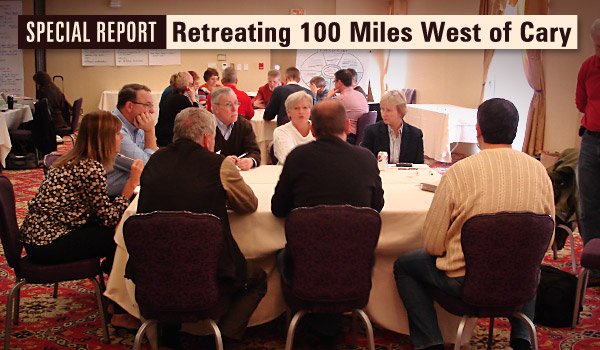
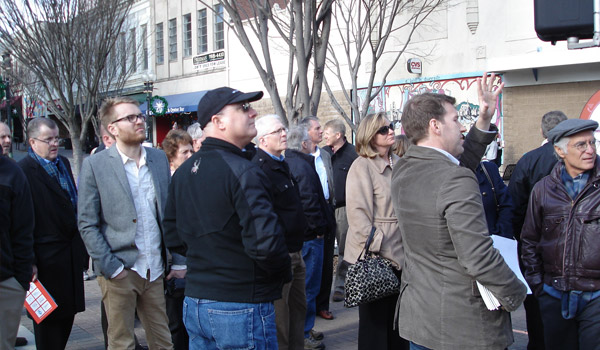
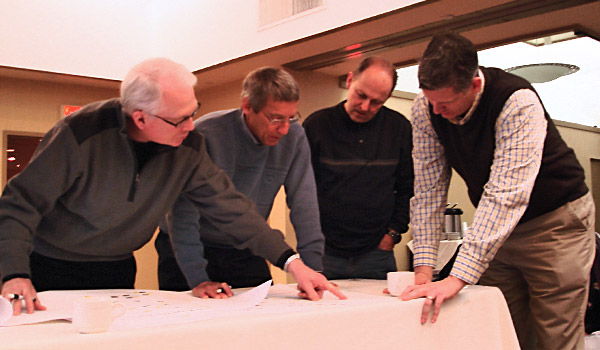
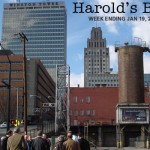
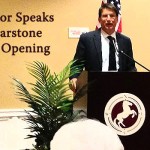
Gosh, TOC sure hates transit (rail). They want to even spend money to build a bridge over it.
Meanwhile, job growth so close to Cary will drive the need for commuter rail:
http://www.wncn.com/story/24618961/rtp-announces-changes-that-will-include
Posted: Feb 03, 2014 11:29 AM EST Updated: Feb 03, 2014 11:29 AM EST
by WNCN Staff
DURHAM, N.C. –
The Research Triangle Park is looking to become a place where people live and work, according to a new vision of the park announced Monday by Bob Geolas, president of the Research Triangle Park.
The 7,000-acre park has purchased several more parcels to add to its size and will have mixed-use development there.
It’s a major change for the park, which began in the 1950s and began to rise to national prominence when companies like IBM shifted workers to RTP in the 1960s.
Geolas said a key part of the new RTP will be commuter rail.
“We are absolutely committed to dedicated rail,” Geolas said.
Greetings, Bob.
On the first point, Mr. Thiel’s main point seemed to be that closing streets was bad, and then he went on to talk about “complete streets” with 2-way traffic flow. I can’t recall which street we were on when he said this, but it was a 2-way major street. Many of the downtown streets were 2-way, with parking on one or both sides. He stated this as a philosophy, so maybe some of it is still an aspiration and not yet accomplished.
On the second point, perhaps you should compare notes with Mr. Smith. :-) I recall that just a year or two ago, the major retreat theme was to call Cary “remarkable”. That adjective got repeated dozens of times during the retreat, but I don’t think I’ve heard it used to describe Cary since then. Maybe we need a succinct tag line that will stick.
Brent – Thanks for the detail in the article. Lots of areas to comment on, but two things stood out to me.
First, it was written that “Mr. Thiel noted the use of ‘complete streets’ in the downtown area, where traffic flows in both directions … “. Is that new to Winston? I lived there years ago and visited just a couple months ago and the north/south streets like Cherry and Marshall in downtown were still both one-way streets. Many of the east/west streets were still one-way also. Has all that changed?
Second, the Jack Smith quote of “How do we convey our message that we’re a dynamic town?” stuck in my head. I’ve lived here for 16 years and have described Cary to many people and have never used the word “dynamic”.
Quote:
Most town communications still occurs via television and newspaper; that’s where most people still get information, although more is being done with email, web and social media.
I wonder if that is an accurate statistic? Cary TV11 is of little use to our household today, and the Cary News, a subsidiary of the N&O gets lost in both print and web.
I found this surprising also, Robert, especially in light of the fact that Cary recently approved an ordinance amendment to no longer require that public notices be published in the local newspaper. Cary has an extraordinarily high share of the population with Internet access (if I recall correctly, 98%).
I did not see the data behind this, although I *think* it reflects responses from the biennial citizen survey.